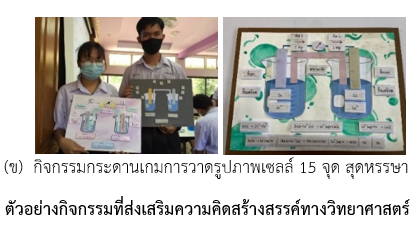การพัฒนาความคิดสร้างสรรค์ทางวิทยาศาสตร์และผลสัมฤทธิ์ทางการเรียนของนักเรียนชั้นมัธยมศึกษาปีที่ 5 โดยใช้รูปแบบการจัดการเรียนรู้แบบสืบเสาะผนวกความคิดสร้างสรรค์ทางวิทยาศาสตร์: PIEGA MODEL เรื่อง เคมีไฟฟ้า
Main Article Content
บทคัดย่อ
การวิจัยครั้งนี้มีจุดมุ่งหมาย เพื่อการพัฒนาความคิดสร้างสรรค์ทางวิทยาศาสตร์ และผลสัมฤทธิ์ทางการเรียนของนักเรียนชั้นมัธยมศึกษาปีที่ 5 โดยใช้รูปแบบการจัดการเรียนรู้แบบสืบเสาะผนวกความคิดสร้างสรรค์ทางวิทยาศาสตร์: PIEGA MODEL เรื่อง เคมีไฟฟ้า กลุ่มตัวอย่าง เป็นนักเรียนชั้นมัธยมศึกษาปีที่ 5 แผนการเรียนวิทยาศาสตร์-คณิตศาสตร์ โรงเรียนอ่างทองปัทมโรจน์วิทยาคม จังหวัดอ่างทอง ภาคเรียนที่ 2 ปีการศึกษา 2564 จำนวน 30 คน ได้มาจากการสุ่มแบบกลุ่ม งานวิจัยนี้เป็นวิจัยเชิงทดลองเบื้องต้น เครื่องมือที่ใช้ในการวิจัย คือ 1) แผนการจัดการเรียนรู้แบบสืบเสาะผนวกความคิดสร้างสรรค์ทางวิทยาศาสตร์: PIEGA MODEL ประกอบด้วย 5 ขั้นตอน คือ เตรียมความพร้อมและวางเป้าหมายของทีม สืบเสาะหาความรู้ แลกเปลี่ยนเรียนรู้และนำเสนอผลงาน การสร้างคำอธิบายทางวิทยาศาสตร์ และประเมินความรู้ 2) แบบวัดความคิดสร้างสรรค์ทางวิทยาศาสตร์ ตามกรอบแนวคิด The Scientific Structure Creativity Model (SSCM) และ 3) แบบทดสอบวัดผลสัมฤทธิ์ทางการเรียน การวิเคราะห์ข้อมูลใช้ร้อยละ ค่าเฉลี่ย ส่วนเบี่ยงเบนมาตรฐาน และการทดสอบค่าที ผลการวิจัยพบว่า 1) ระดับความคิดสร้างสรรค์ทางวิทยาศาสตร์ของนักเรียนหลังเรียนโดยใช้ PIEGA MODEL โดยภาพรวม นักเรียนทุกคนอยู่ในระดับดีมาก พิจารณารายมิติพบว่ามิติด้านคุณลักษณะ นักเรียนส่วนใหญ่ ร้อยละ 76.67 อยู่ในระดับดีมาก มิติด้านกระบวนการทางวิทยาศาสตร์ นักเรียนทุกคนอยู่ในระดับดีมาก มิติด้านผลลัพธ์ ด้านความเชี่ยวชาญเฉพาะเรื่อง ด้านความรู้ทางวิทยาศาสตร์ นักเรียนส่วนใหญ่อยู่ในระดับดีมาก คิดเป็นร้อยละ 86.67 และ 100.00 ตามลำดับ ด้านปรากฎการทางวิทยาศาสตร์ x จินตนาการทางวิทยาศาสตร์ นักเรียนส่วนใหญ่ ร้อยละ 66.67 อยู่ในระดับดีมาก ด้านปรากฎการทางวิทยาศาสตร์ x การคิดทางวิทยาศาสตร์ นักเรียนส่วนใหญ่ ร้อยละ 53.34 อยู่ในระดับดี และ ด้านการปัญหาทางวิทยาศาสตร์ นักเรียนส่วนใหญ่อยู่ในระดับดี คิดเป็น ร้อยละ 63.33 2) ผลสัมฤทธิ์ทางการเรียนของนักเรียนหลังเรียน สูงกว่าก่อนเรียนอย่างมีนัยสำคัญทางสถิติที่ระดับ .01
Article Details

อนุญาตภายใต้เงื่อนไข Creative Commons Attribution-NonCommercial-NoDerivatives 4.0 International License.
วารสารวิทยาศาสตร์และวิทยาศาสตร์ศึกษา (JSSE) เป็นผู้ถือลิสิทธิ์บทความทุกบทความที่เผยแพร่ใน JSSE นี้ ทั้งนี้ ผู้เขียนจะต้องส่งแบบโอนลิขสิทธิ์บทความฉบับที่มีรายมือชื่อของผู้เขียนหลักหรือผู้ที่ได้รับมอบอำนาจแทนผู้เขียนทุกนให้กับ JSSE ก่อนที่บทความจะมีการเผยแพร่ผ่านเว็บไซต์ของวารสาร
แบบโอนลิขสิทธิ์บทความ (Copyright Transfer Form)
ทางวารสาร JSSE ได้กำหนดให้มีการกรอกแบบโอนลิขสิทธิ์บทความให้ครบถ้วนและส่งมายังกองบรรณาธิการในข้อมูลเสริม (supplementary data) พร้อมกับนิพนธ์ต้นฉบับ (manuscript) ที่ส่งมาขอรับการตีพิมพ์ ทั้งนี้ ผู้เขียนหลัก (corresponding authors) หรือผู้รับมอบอำนาจ (ในฐานะตัวแทนของผู้เขียนทุกคน) สามารถดำเนินการโอนลิขสิทธิ์บทความแทนผู้เขียนทั้งหมดได้ ซึ่งสามารถอัพโหลดไฟล์บทความต้นฉบับ (Manuscript) และไฟล์แบบโอนลิขสิทธิ์บทความ (Copyright Transfer Form) ในเมนู “Upload Submission” ดังนี้
1. อัพโหลดไฟล์บทความต้นฉบับ (Manuscript) ในเมนูย่อย Article Component > Article Text
2. อัพโหลดไฟล์แบบโอนลิขสิทธิ์บทความ (Copyright Transfer Form) ในเมนูย่อย Article Component > Other
ดาวน์โหลด ไฟล์แบบโอนลิขสิทธิ์บทความ (Copyright Transfer Form)
เอกสารอ้างอิง
Guilford, J.P. (1967). The Nature of Human Intelligence. New York: McGraw-Hill Book Co.
Junthon, B., Jantarakantee, E., Weerapaspong, T. (2015). Developing of Scientific Creativity of Grade 11 Students in Unit of Equilibrium Using by Scientific Inquiry Approach. 53rd Kasetsart University Academic Conference: Branches Education. Pages 227-234.
Jumpathong, W. (2019). Development of STEM activity by using microfluidic paper-based analytical devices on acid-base solutions to enhance creativity and innovation skills for pre-service teachers. A Thesis Submitted in Partial Fulfillment of the Requirements for the Degree of MASTER OF EDUCATION, Faculty of Science Srinakharinwirot University.
Hu, W., Shi, Q.Z., Han,Q., Wang, X., and Adey, P. (2010). Creative Scientific Problem Finding and
its Developmental Trend. Creativity Research Journal, 22(1). Pages 1-7.
Kaewdok, P., Sawangboon, T. (2018). A Study of the Learning Achievement and Scientific Creative Thinking of Tenth Grade Students, Using Creativity–Based Learning (CBL): Mixed–Method Research. Journal of Educational Measurement, Mahasarakham University. Year 25, Issue 1 January - June 2019. Pages 206-224.
Karademir, E. (2016). Investigation the scientific creativity of gifted students through project-based activities. International Journal of Research in Education and Science (IJRES). 2(2). Pages 416-427.
Karakul, R., Nuangchalerm, P. (2016). The Development of Science Activity Packages Based on Constructivist Theory for Mathayomsuksa 4. Praewa Kalasin Academic Journal Kalasin University. Year 3, Issue 2 May - August 2016. Pages 38-53.
Khalid, F., Ahmad, M., Karim, A., Daud, M., Din, R. (2015). Reflective Thinking: An Analysis of Students’
Reflections in Their Learning about Computers in Education. Creative Education. 6. Pages 2160-
National Research Council. (2000). Inquiry and the National Science Education Standards: A guide for teaching and learning. Washington, DC: National Academies Press.
Mingsiritham, K. (2011). Integrating cooperative learning and collaborative learning. Veridian E-Journal SU. Vol.4, No.1 May - August 2011. Pages 435-444.
Paking, K., Kong-im, B. Wangwasit,K. (2015). Development of teaching processes that promote scientific creativity. of students in Grade 1. Academic Social Science Journal. Year 8, Issue 2 February - May 2015. Pages 30-53.
Saengaroon, S. Chaowakeratipong, N. Suwanjinda, D. (2021). The Effects of Using the Model-Based Instruction in the Topic of Chemical Bonding on Chemistry Learning Achievement and Scientific Creative Thinking of Grade 10 Students at Wat SuthiWararam School in Bangkok Metropolis. Education Journal Thaksin University. Year 21, No. 2 July - December 2021. Pages 157-173.
Senglek, M. Arunwong, R. Othakanon, L. (2021). The study of factors related to enhance of scientific creativity and scientific mind of students grade 4-6. Valayalongkorn Review Journal (Humanities and Social Sciences). Year 11, Issue 2 May - August 2021. Pages 91-103.
Siew, N, M., Lee, B, N. (2021). Scientific creativity test for fifth graders: Development and validation. Man In India. 97 (17). Pages 195-207.
Suphautumporn, P. (2018). Effects of using a 5-step learning cycle model on the ability to think scientifically. and the ability to think scientifically of junior high school students in Chulalongkorn University Demonstration School, Secondary Department. Education Journal Chulalongkorn University. Year 46, No. 2 April - June 2018. Pages 101-118.
Suwannatat, W., Tunsakul, J., Rorbkorb, N., Rascha, T. (2020). Confirmatory Factor Analysis of Scientific Creativity. Journal of Education, Prince of Songkla University, Pattani Campus. Vol.31, No.3 September - December 2020. Pages 190-198.
Thongjun, N., Pankaew, P. (2016). Development of creative thinking in science of lower secondary students learning through brain storming. Graduate Research Journal. Year 7, No. 1 January - June 2016. Pages 1-14.
Treffinger, D. J., Young, G. C. Nassab, C. W. & Witting, C. V. (2004). Talent development: The levels of service approach. Waco, TX: Prufrock Press.
Upaphan, K. (2021). Developing Creativity by Using the Teaching and Learning Model of Thinking Process. Solve future problems based on Torrance's concept. Knowledge integration course Mahidol Wittayanusorn School. Nakhon Pathom: Mahidol Wittayanusorn School Public Organization.
Weiping Hu and Philip Adey. (2002). A scientific creativity test for secondary school students. International Journal of Science Education, 24(4), 389–403.


